The DeWitt Wallace Gallery is home to an extensive collection of over 10,000 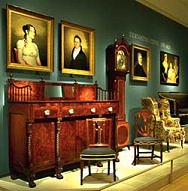 pieces of 17th- to 19th-century English and American decorative art. Within the galleries, guests can view period furnishings, ceramics, silver, clocks, pewter, weapons and firearms, textiles, costumes, mechanical tools and scientific instruments. Charles Willson Peale's portrait of George Washington, is among the many famous and fine paintings displayed. The gallery was designed by Kevin Roche, an internationally honored architect. The Public Hospital, which serves as the entrance to the Gallery, offers a glimpse at how physicians treated mental illnesses in the 18th- and 19th-centuries. pieces of 17th- to 19th-century English and American decorative art. Within the galleries, guests can view period furnishings, ceramics, silver, clocks, pewter, weapons and firearms, textiles, costumes, mechanical tools and scientific instruments. Charles Willson Peale's portrait of George Washington, is among the many famous and fine paintings displayed. The gallery was designed by Kevin Roche, an internationally honored architect. The Public Hospital, which serves as the entrance to the Gallery, offers a glimpse at how physicians treated mental illnesses in the 18th- and 19th-centuries.
Art continues to abound in Williamsburg, as you travel a short distance 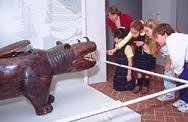 down the road to The Abby Aldrich Rockefeller Folk Art Center. It is here that one of the finest collections of useful, everyday implements and ornamental treasures, created by untrained artists and craftsman are displayed from colonial times. The creativity of these artists are seen in the variety of carvings, toys, and needlework they created. Mrs. Rockefeller was one of the pioneers in collecting artifacts such as these to portray a visual history of life in times past. Over 2,600 items from her private collection are displayed at the Center. down the road to The Abby Aldrich Rockefeller Folk Art Center. It is here that one of the finest collections of useful, everyday implements and ornamental treasures, created by untrained artists and craftsman are displayed from colonial times. The creativity of these artists are seen in the variety of carvings, toys, and needlework they created. Mrs. Rockefeller was one of the pioneers in collecting artifacts such as these to portray a visual history of life in times past. Over 2,600 items from her private collection are displayed at the Center.
One of the first plantations in Williamsburg was Carter's Grove, located southeast of the Historic Area on the James River. The property was originally purchased by Robert Carter for his daughter. Between 1751 and 1754, her son, 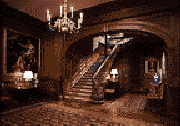 Carter Burwell built the magnificent main house. This grand Georgian Mansion, has been continuously occupied since then. The west drawing room has been nicknamed the "Refusal Room". Legend has it that both George Washington and Thomas Jefferson made offers of marriage there and were both turned down. Carter Burwell built the magnificent main house. This grand Georgian Mansion, has been continuously occupied since then. The west drawing room has been nicknamed the "Refusal Room". Legend has it that both George Washington and Thomas Jefferson made offers of marriage there and were both turned down.
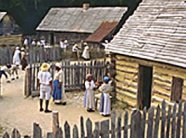 Reconstructed on the grounds, are slave quarters which present life at it was lived by the slave during that time. Two double houses, a corn crib, a single-family dwelling, small garden plots, and chicken pens positioned around a courtyard represent a small slave community. There are few possession or furnishings, except for straw pallets that were places on the floors for sleeping. The foreman's (senior slave's) house was furnishing better and included an actual bed, chair , table and mirror. Reconstructed on the grounds, are slave quarters which present life at it was lived by the slave during that time. Two double houses, a corn crib, a single-family dwelling, small garden plots, and chicken pens positioned around a courtyard represent a small slave community. There are few possession or furnishings, except for straw pallets that were places on the floors for sleeping. The foreman's (senior slave's) house was furnishing better and included an actual bed, chair , table and mirror.
Williamsburg is home to four taverns that have reopened since their initial serving to the public since the 1700's. Kings Arms Tavern was opened by Mrs. Jane Vobe in 1772, offering the finest fare to the wealthy, influential residents of Williamsburg. Among the menu favorites are Roast Prime Rib of Beef, Peanut Soup, Game Pie and Polled Salmon. Outbuildings have been reconstructed on the property on the property, including a barbershop, laundry, kitchen, smokehouse and stables.
Shields Tavern, was run by James Shields in the early 1740s, and hosted
a 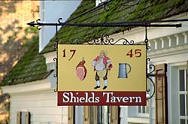 crowd of lower gentry. This is the largest Williamsburg tavern and is composed of 11 dining rooms, plus an outdoor dining garden. 18th Century roasting techniques have been perfected with the used a specially designed rotisserie unit. Specialties of the house include Mixed Grill of Wild Boar Sausage and Quail, Syllabub with Fresh Berries, Crayfish Soup, Polenta, plus dishes from the first recipes for Fried Chicken and Macaroni and Cheese. crowd of lower gentry. This is the largest Williamsburg tavern and is composed of 11 dining rooms, plus an outdoor dining garden. 18th Century roasting techniques have been perfected with the used a specially designed rotisserie unit. Specialties of the house include Mixed Grill of Wild Boar Sausage and Quail, Syllabub with Fresh Berries, Crayfish Soup, Polenta, plus dishes from the first recipes for Fried Chicken and Macaroni and Cheese.
In 1766, Josiah Chowning's Tavern was opened in the fashion of an English alehouse-style tavern for common folk, announcing it as a place "where all who please to favour me with their custom may depend upon the best of entertainment for themselves, servants, and horses, and good pasturage." The menu is reminiscent of the fare from an 18th-century English pub, offering Fish and Chips, Shepherd's Stew, Bubble and Squeak Brunswick Stew, and Cider Cake. Entertainment abounds in the evening, featuring "Gambols," a night of colonial board games, music, and magic.
Christiana Campbell's Tavern was a favorite of George Washington's during his years in the House of Burgesses. The restaurant opened in 1765 and quickly became known for it's seafood specialties. Today, Christiana Campbell's offers dishes reflecting the traditional seafood of the original thirteen colonies. Among the sampling of traditional plates are other Americana favorites including Clam Chowder, Sweet Potato Muffins, Crab Cakes, Oyster Fritters, Codfish Cakes, and Fish Muddle.
Williamsburg continued... |

 pieces of 17th- to 19th-century English and American decorative art. Within the galleries, guests can view period furnishings, ceramics, silver, clocks, pewter, weapons and firearms, textiles, costumes, mechanical tools and scientific instruments. Charles Willson Peale's portrait of George Washington, is among the many famous and fine paintings displayed. The gallery was designed by Kevin Roche, an internationally honored architect. The Public Hospital, which serves as the entrance to the Gallery, offers a glimpse at how physicians treated mental illnesses in the 18th- and 19th-centuries.
pieces of 17th- to 19th-century English and American decorative art. Within the galleries, guests can view period furnishings, ceramics, silver, clocks, pewter, weapons and firearms, textiles, costumes, mechanical tools and scientific instruments. Charles Willson Peale's portrait of George Washington, is among the many famous and fine paintings displayed. The gallery was designed by Kevin Roche, an internationally honored architect. The Public Hospital, which serves as the entrance to the Gallery, offers a glimpse at how physicians treated mental illnesses in the 18th- and 19th-centuries.
 down the road to The Abby Aldrich Rockefeller Folk Art Center. It is here that one of the finest collections of useful, everyday implements and ornamental treasures, created by untrained artists and craftsman are displayed from colonial times. The creativity of these artists are seen in the variety of carvings, toys, and needlework they created. Mrs. Rockefeller was one of the pioneers in collecting artifacts such as these to portray a visual history of life in times past. Over 2,600 items from her private collection are displayed at the Center.
down the road to The Abby Aldrich Rockefeller Folk Art Center. It is here that one of the finest collections of useful, everyday implements and ornamental treasures, created by untrained artists and craftsman are displayed from colonial times. The creativity of these artists are seen in the variety of carvings, toys, and needlework they created. Mrs. Rockefeller was one of the pioneers in collecting artifacts such as these to portray a visual history of life in times past. Over 2,600 items from her private collection are displayed at the Center.
 Carter Burwell built the magnificent main house. This grand Georgian Mansion, has been continuously occupied since then. The west drawing room has been nicknamed the "Refusal Room". Legend has it that both George Washington and Thomas Jefferson made offers of marriage there and were both turned down.
Carter Burwell built the magnificent main house. This grand Georgian Mansion, has been continuously occupied since then. The west drawing room has been nicknamed the "Refusal Room". Legend has it that both George Washington and Thomas Jefferson made offers of marriage there and were both turned down.
 Reconstructed on the grounds, are slave quarters which present life at it was lived by the slave during that time. Two double houses, a corn crib, a single-family dwelling, small garden plots, and chicken pens positioned around a courtyard represent a small slave community. There are few possession or furnishings, except for straw pallets that were places on the floors for sleeping. The foreman's (senior slave's) house was furnishing better and included an actual bed, chair , table and mirror.
Reconstructed on the grounds, are slave quarters which present life at it was lived by the slave during that time. Two double houses, a corn crib, a single-family dwelling, small garden plots, and chicken pens positioned around a courtyard represent a small slave community. There are few possession or furnishings, except for straw pallets that were places on the floors for sleeping. The foreman's (senior slave's) house was furnishing better and included an actual bed, chair , table and mirror.
 crowd of lower gentry. This is the largest Williamsburg tavern and is composed of 11 dining rooms, plus an outdoor dining garden. 18th Century roasting techniques have been perfected with the used a specially designed rotisserie unit. Specialties of the house include Mixed Grill of Wild Boar Sausage and Quail, Syllabub with Fresh Berries, Crayfish Soup, Polenta, plus dishes from the first recipes for Fried Chicken and Macaroni and Cheese.
crowd of lower gentry. This is the largest Williamsburg tavern and is composed of 11 dining rooms, plus an outdoor dining garden. 18th Century roasting techniques have been perfected with the used a specially designed rotisserie unit. Specialties of the house include Mixed Grill of Wild Boar Sausage and Quail, Syllabub with Fresh Berries, Crayfish Soup, Polenta, plus dishes from the first recipes for Fried Chicken and Macaroni and Cheese.














